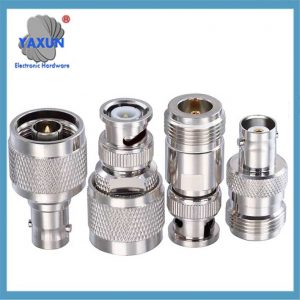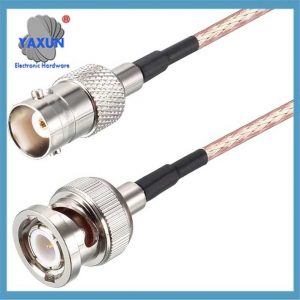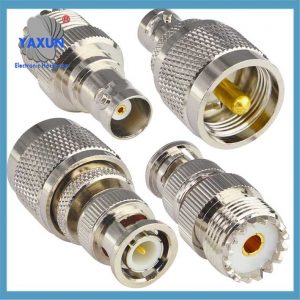PCB coaxial RF connector is a component installed on a cable or mounted on an instrument. As a component for electrical connection or separation of transmission lines, it belongs to mechatronics products and mainly plays a bridging role. The following is a detailed introduction to PCB coaxial RF connectors:
1. Definition and Use
PCB coaxial RF connectors are used to connect coaxial transmission lines, realize interconnection between devices or modules, and effectively transmit RF and microwave signals. It is widely used in wireless communication, broadcasting, television, radar, satellite communication, electronic equipment, computer, attrezzature mediche, industry, automobiles and other fields.
 N to BNC Coax Adapter Cable Gender Changers, N Male/Female to BNC Male/Female Coaxial Connector Kit |
 BNC Male to BNC Female HD-SDI Cable RG316 RF Coaxial Coax Antenna Pigtail Jumper 50 Ohm BNC Connector Adapter |
 BNC to UHF 4 Type RF Connector Kit Coaxial BNC Male Female to PL259 SO239 Radios Adapter Kit for Antennas |
2. Types and Specifications
PCB coaxial RF connectors are of various types, including SMA, SMB, BNC and other types, as well as specifications of different sizes and frequency ranges. For example, different types of coaxial connectors such as 3.5mm, 2.92mm, 2.4mm and 1.85mm have different maximum frequencies between manufacturers, depending on their structure, materials and tolerances.
3. Structure and Features
Structure: PCB coaxial RF connectors are usually composed of center conductor, insulator, outer conductor (shielding layer) and connector.
Features:
High-frequency transmission performance: It can support the stable transmission of high-frequency signals and meet the requirements of modern communication technology for data transmission rate and bandwidth.
Strong anti-interference ability: It has good anti-interference ability, can effectively prevent signal interference and noise interference, and ensure the reliability and clarity of signal transmission.
Easy to install and maintain: It is usually designed with a structure that is easy to connect and disconnect, which is convenient and quick to adjust, and improves installation and maintenance efficiency.
IV. Application Cases
In wireless communication systems, PCB coaxial RF connectors are used to connect mobile phones, base stations, wireless routers and other devices to achieve signal transmission and antenna connection. In radar systems, they connect antennas and signal processing equipment to achieve radar signal collection and processing. In addition, PCB coaxial RF connectors also play an important role in fields such as broadcasting, television, satellite communications, electronic equipment and medical equipment.
V. Selection and Use Precautions
Choose the appropriate type and specification: Choose the appropriate PCB coaxial RF connector type and specification according to application requirements and working environment.
Pay attention to installation and maintenance: During installation, ensure that the connector is properly docked and fixed; during maintenance, regularly check the performance and status of the connector, and replace damaged or aged connectors in time.
Prevent signal interference and loss: During use, pay attention to prevent signal interference and loss, and ensure the stability and clarity of signal transmission.
In summary, PCB coaxial RF connectors play an important role in modern communication technology. Understanding and mastering the relevant knowledge will help to better apply and maintain these connectors, ensuring the normal operation of the communication system and the quality of signal transmission.
 English
English العربية
العربية Български
Български Čeština
Čeština Dansk
Dansk Nederlands
Nederlands Suomi
Suomi Français
Français Deutsch
Deutsch Magyar
Magyar Italiano
Italiano 日本語
日本語 한국어
한국어 Português
Português Română
Română Русский
Русский Slovenščina
Slovenščina Español
Español Svenska
Svenska Tiếng Việt
Tiếng Việt
